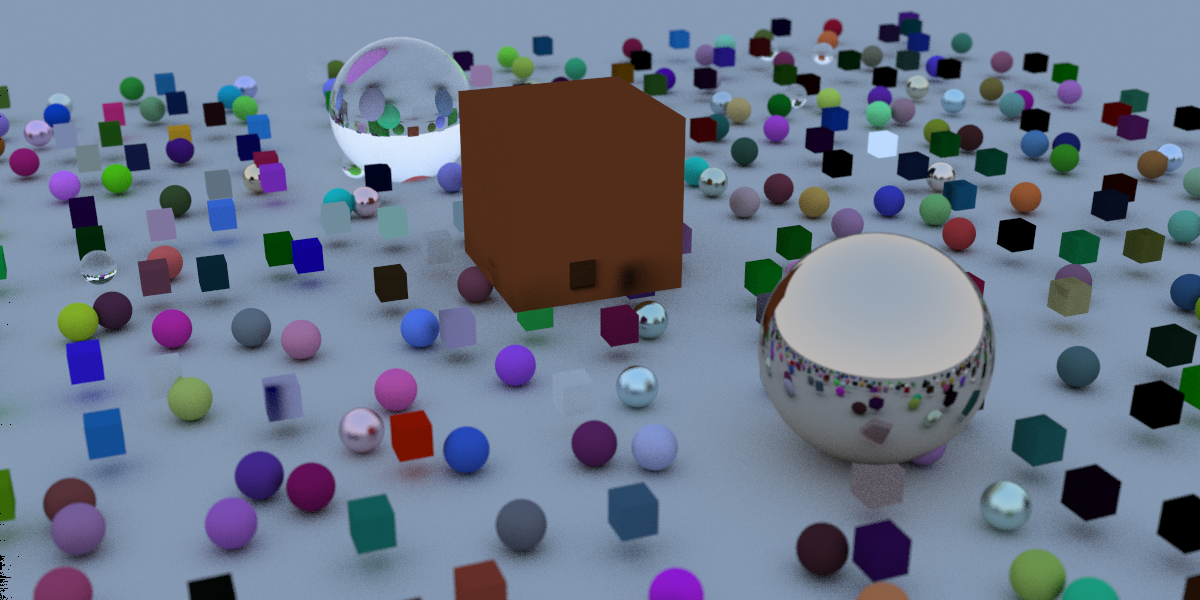C++ / OpenCL Ray Tracer based on Peter Shirley's Ray Tracing in One Weekend
The ray tracer function is contained in the RayTracer.h file.
To initialize a ray tracer, create a new instance: RayTracer* tracer = new RayTracer(DIMENSIONS, QUALITY, CAMERA)†.
†: Camera setting is optional
Then, set the camera parameters for the output image (only necessary if not initialized in first step): tracer->SetCamera(...).
Next, use the following format for each object in the render: tracer->AddItem(new OBJECT).
Then, call the render function to output an image: tracer->Render(FILENAME) or tracer->clRender(FILENAME).
Use Render() to render in C++ on the CPU or clRender() to render in OpenCL on the GPU.
Finally, destruct the instance: delete tracer; or ray_tracer->ClearItems();.
Optionally, you may display the performance data or automatically open the image in the default image viewer by calling: ray_tracer->ShowPerformance(); or ray_tracer->OpenImage();
Example:
#include "ray_tracer.h"
int main() {
RayTracer* tracer = new RayTracer({ 200, 100 });
tracer->SetCamera(Vector3D(10, 0, 0));
tracer->AddItem(&Sphere(Vector3D(0,0,0), 1, new Dielectric(1.3)));
tracer->Render("ImageName");
delete tracer;
return 0;
}
OBJECT:Sphere:- Description: Sphere Object
- Format:
Sphere(Vector3D(LOCATION), SIZE, MATERIAL) - Example:
Sphere(Vector3D(0), 1, new Lambertian(Vector3D(0.51, 0.7, 1.0)))
Box- Description: Box Object
- Format:
Box(Vector3D(BOUND1), Vector3D(BOUND2), MATERIAL) - Example:
Box(Vector3D(-1), Vector3D(1), new Lambertian(Vector3D(1, 0, 0)))
LOCATION: (X,Y,Z) location of object (double).SIZE: Sphere radius (double).MATERIAL:Lambertian- Example:
new Lambertian(Vector3D(COLOR)). COLOR: (R,G,B) color value, 0.0 - 1.0 (Vector3D).
- Example:
Metal- Example:
new Metal(Vector3D(COLOR), FUZZ). COLOR: (R,G,B) color value, 0.0 - 1.0 (Vector3D).FUZZ: Fuzz / Blur Level, 0.1 - 1.0 (double).
- Example:
Dialectric:- Example:
new Dielectric(REFIDX). REFIDX: Refractive Index. Recommended 1.0 - 2.4 (double).
- Example:
DIMENSIONS: Output image size in pixels. Width x Height (SDims).QUALITY: Number of rays per pixel (double).CAMERA- Format: Camera(DIMS, LOOKFROM, LOOKAT, UP, APERTURE, FOV)
- Example:
Camera(dims, Vector3D(3, 1, 3), Vector3D(0, 0, 0), Vector3D(0, 1, 0), 0.1, 30) DIMS: Output image size in pixels. Width x Height (SDims).LOOKFROM: (X,Y,Z) location of camera (Vector3D).LOOKAT(Optional): (X,Y,Z) location where camera is pointed (Vector3D).UP(Optional): (X,Y,Z) location of camera y-shift (Vector3D).APERTURE(Optional): Camera lens aperture (double).FOV(Optional): Camera lens field of view in degrees (double).
FILENAME: Name for ouput ppm file. Do not include.ppm(string).
Note: Vector3D can be intialized with one or three paramaters. If one paramater is supplied, all three will use that value. i.e: Vector3D(1) == Vector3D(1,1,1).
